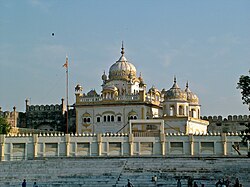During the 18th century, as Mughal power dwindled, Lahore was often invaded by Afghan armies and became a province of the Afghan Empire, governed by provincial rulers with their own court.
Sikh rule in Lahore began with the the rule of the Sikh Misls and continued with the Sikh Empire of Ranjit Singh (also known as Punjab, the Sikh Raj, and Sarkar Khālsā Rāj)[16] which ended in 1849.[17] The Sikhs began gaining power following the decline of the Mughal Empire in Punjab and consisted of a collection of autonomous Punjabi Misls, which were governed by Misldars,[18] mainly in the Punjab region.
Rebellion against the Mughal Empire
Early in Aurangzeb's reign, various insurgent groups of Sikhs engaged Mughal troops in increasingly bloody battles. In 1670, the ninth Sikh Guru,Guru Tegh Bahadur encamped in Delhi, receiving large numbers of followers, was said to have attracted the wrath of Emperor Aurangzeb.[19]
The execution of Guru Tegh Bahadur infuriated the Sikhs. In response, his son and successor, the tenth Guru of Sikhism Guru Gobind Singh further militarized his followers.
The Khalsa, or the Sikh Army, were the first in history to abolish the Muslim states and Mughal Empire in the whole province of Punjab in one stroke.[20] The Singhs (Lions), led by Banda Singh Bahadur took over many Muslim and Mughal lands, establishing a Sikh Empire.
Other existing Muslim Emperors proclaimed a war against the Banda and the Khalsa. However many Muslim armies and their Emperors fled in dismay and despair after Wazir Khan's head was stuck up on a spear and lifted high up by a Sikh who took his seat at Sirhind, Muslim troops on beholding the head took alarm. Many Muslims embraced Sikhism and became Khalsa.
Ranjit Singh's Empire

Ranjit Singhwas crowned on 12 April 1801 at Lahore. The 1740s were years of chaos, and the city had nine different governors between 1745 and 1756. Invasions and chaos in local government allowed bands of warring Sikhs to gain control in some areas. In 1799, all Sikh Misls (warring bands) joined into one to form a sovereign Sikh state ruled byMaharaja Ranjit Singh from the royal capital, Lahore. During the 1740s, frequent invasions by Afghans led by Ahmad Shah Abdali and chaos in local government had made life very uncomfortable for the citizens of Lahore. Bhangi Misl was the fist Sikh band to invade and plunder the Mughal Lahore. Later Ranjit Singh was able to make gains in this chaos. He defeated the son of Abdali,Zaman Shah in a battle between Lahore and Amritsar. Out of the chaos of Afghani and Sikh conflicts emerged a victorious Sikh by the name of Ranjit Singh who was able to unify the Sikh factions and capture Lahore where he was crowned Emperor.
On 7 July 1799, the Sikh militia of the Sukerchakia chief, Ranjit Singh, occupied of Lahore.[21] For that brief half century, from 1799 to 1846, Lahore recovered under the patronage of Ranjit Singh and his successors. Ranjit Singh consolidated the Sikh misls who had ruled more or less independently during the eighteenth century under a unified command and in 1799 he established Lahore as the administrative capital of a new Sikh kingdom. Nearby Amritsar became the spiritual and commercial center of the kingdom in 1802, after Ranjit Singh's troops occupied the city and the maharaja announced his intention to extend patronage and protection to the city's leading groups.
While much of Lahore'sMughal era fabric lay in ruins by the end of eighteenth century, rebuilding efforts under the Sikhs were focused on the Sikh community as many visitors to the city noted that much of the city was in disrepair and many of its Mauseleums and Mosques were pillaged and desecrated; in many instances components were pillaged from ancient structures to build Sikh temples and houses. The grand Badshahi mosque was used as a horse stable and the minaret used as targets by the Sikh artillery regiments. Much of the city's Muslim inhabitants suffered considerably during this time and the period is generally associated with the descretion of much of Lahore's ancient architectural wonders.
Ranjit Singh death in 27 June 1839 ultimately ended his reign, while his son Dalip Singh became his successor. He was buried in Lahore and hissamadhi still stands there.




No comments:
Post a Comment